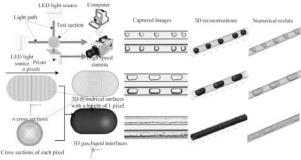当前位置:
X-MOL 学术
›
Int. J. Multiphase Flow
›
论文详情
Our official English website, www.x-mol.net, welcomes your feedback! (Note: you will need to create a separate account there.)
Studies of gas-liquid two-phase flows in horizontal mini tubes using 3D reconstruction and numerical methods
International Journal of Multiphase Flow ( IF 3.8 ) Pub Date : 2020-12-01 , DOI: 10.1016/j.ijmultiphaseflow.2020.103456 Jingzhi Zhang , Nanyan Huang , Li Lei , Fushun Liang , Xinyu Wang , Zan Wu
International Journal of Multiphase Flow ( IF 3.8 ) Pub Date : 2020-12-01 , DOI: 10.1016/j.ijmultiphaseflow.2020.103456 Jingzhi Zhang , Nanyan Huang , Li Lei , Fushun Liang , Xinyu Wang , Zan Wu

|
Abstract In order to study the characteristics of 3D gas-liquid interfaces, flow pattern transitions, and void fraction in mini tubes, virtual multi-vision experiments and numerical simulations are conducted in a 5.16 mm horizontal tube with air as the dispersed phase and water as the continuous phase. Air and water flow velocities range from 0.024 to 12.330 m/s and from 0.039 to 0.942 m/s, respectively. A simple setup is adopted to capture images synchronously from two orthogonal views with a prism. 3D gas-liquid interfaces of bubbly, slug, and annular flows in horizontal mini tubes are reconstructed in Matlab based on the captured images. Flow pattern transitions and void fractions with 3D interfaces are comprehensively investigated both experimentally and numerically. The numerical results fit well with experimental data in terms of 3D interfaces, cross-sectional and volumetric void fractions. The results show that three flow patterns (bubbly, slug, and annular) are observed experimentally and numerically. The increases in both bubble size and interfacial fluctuation are the main reasons for flow pattern transitions. Two peaks are observed in the Probability Density Functions figures for intermittent flows, while only one peak is obtained for annular flow. The volumetric void fraction fits well with the homogenous model when the gas quality is lower than 0.8, while the slip ratio is around 1. The velocity difference between the two phases increases dramatically at a higher gas quality, leading to a lower void fraction than the predicted value by the homogenous model. The results agree well with empirical correlations with a mean average deviation about 10%, which validates the experimental and numerical methods in the present work.
中文翻译:

使用 3D 重建和数值方法研究水平微型管中的气液两相流
摘要 为了研究微型管中 3D 气液界面、流型转变和空隙率的特性,在 5.16 mm 水平管中进行虚拟多视觉实验和数值模拟,以空气为分散相,水为分散相。连续相。空气和水的流速范围分别为 0.024 至 12.330 m/s 和 0.039 至 0.942 m/s。采用简单的设置,用棱镜从两个正交视图同步捕获图像。基于捕获的图像在 Matlab 中重建水平微型管中气泡、段塞和环形流的 3D 气液界面。通过实验和数值方法全面研究了具有 3D 界面的流型转变和空隙率。在 3D 界面、横截面和体积空隙率方面,数值结果与实验数据非常吻合。结果表明,实验和数值上观察到了三种流动模式(气泡、段塞和环形)。气泡尺寸和界面波动的增加是流型转变的主要原因。在间歇流动的概率密度函数图中观察到两个峰值,而环形流动仅获得一个峰值。当气体质量低于 0.8 时,体积孔隙率与均质模型拟合良好,而滑移比约为 1。在较高的气体质量下,两相之间的速度差显着增加,导致孔隙率低于均质模型。同构模型的预测值。
更新日期:2020-12-01
中文翻译:

使用 3D 重建和数值方法研究水平微型管中的气液两相流
摘要 为了研究微型管中 3D 气液界面、流型转变和空隙率的特性,在 5.16 mm 水平管中进行虚拟多视觉实验和数值模拟,以空气为分散相,水为分散相。连续相。空气和水的流速范围分别为 0.024 至 12.330 m/s 和 0.039 至 0.942 m/s。采用简单的设置,用棱镜从两个正交视图同步捕获图像。基于捕获的图像在 Matlab 中重建水平微型管中气泡、段塞和环形流的 3D 气液界面。通过实验和数值方法全面研究了具有 3D 界面的流型转变和空隙率。在 3D 界面、横截面和体积空隙率方面,数值结果与实验数据非常吻合。结果表明,实验和数值上观察到了三种流动模式(气泡、段塞和环形)。气泡尺寸和界面波动的增加是流型转变的主要原因。在间歇流动的概率密度函数图中观察到两个峰值,而环形流动仅获得一个峰值。当气体质量低于 0.8 时,体积孔隙率与均质模型拟合良好,而滑移比约为 1。在较高的气体质量下,两相之间的速度差显着增加,导致孔隙率低于均质模型。同构模型的预测值。



























 京公网安备 11010802027423号
京公网安备 11010802027423号